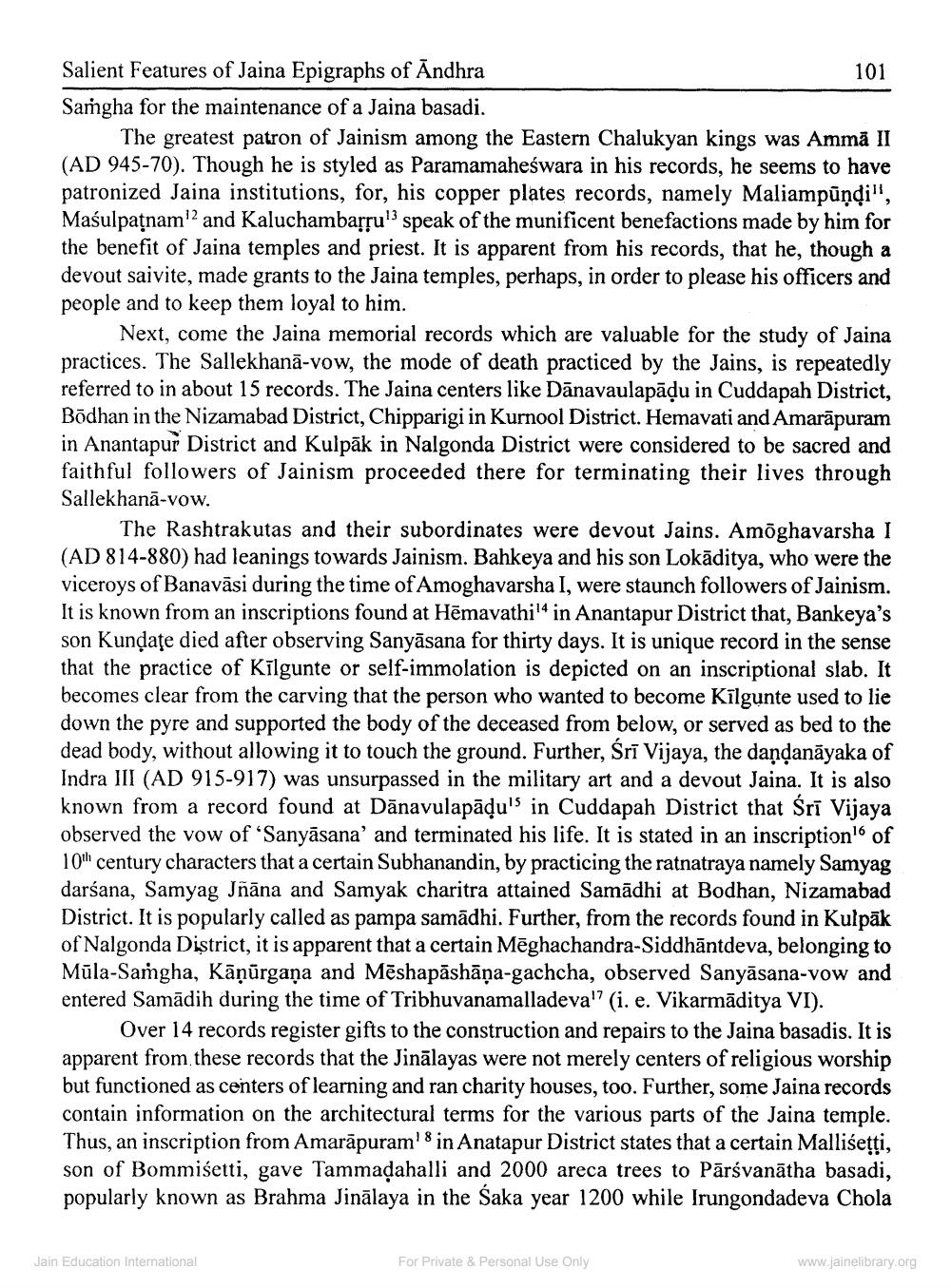________________
Salient Features of Jaina Epigraphs of Andhra
101 Samgha for the maintenance of a Jaina basadi.
The greatest patron of Jainism among the Eastern Chalukyan kings was Ammā II (AD 945-70). Though he is styled as Paramamaheswara in his records, he seems to have patronized Jaina institutions, for, his copper plates records, namely Maliampūņdi", Maśulpatnam2 and Kaluchambarşu' speak of the munificent benefactions made by him for the benefit of Jaina temples and priest. It is apparent from his records, that he, though a devout saivite, made grants to the Jaina temples, perhaps, in order to please his officers and people and to keep them loyal to him.
Next, come the Jaina memorial records which are valuable for the study of Jaina practices. The Sallekhanā-vow, the mode of death practiced by the Jains, is repeatedly referred to in about 15 records. The Jaina centers like Dānavaulapādu in Cuddapah District, Bödhan in the Nizamabad District, Chipparigi in Kurnool District. Hemavati and Amarāpuram in Anantapur District and Kulpāk in Nalgonda District were considered to be sacred and faithful followers of Jainism proceeded there for terminating their lives through Sallekhanā-vow.
The Rashtrakutas and their subordinates were devout Jains. Amõghavarsha I (AD 814-880) had leanings towards Jainism. Bahkeya and his son Lokāditya, who were the viceroys of Banavāsi during the time of Amoghavarsha I, were staunch followers of Jainism. It is known from an inscriptions found at Hēmavathild in Anantapur District that, Bankeya's son Kundate died after observing Sanyāsana for thirty days. It is unique record in the sense that the practice of Kilgunte or self-immolation is depicted on an inscriptional slab. It becomes clear from the carving that the person who wanted to become Kīlgunte used to lie down the pyre and supported the body of the deceased from below, or served as bed to the dead body, without allowing it to touch the ground. Further, Śrī Vijaya, the dandanāya Indra III (AD 915-917) was unsurpassed in the military art and a devout Jaina. It is also known from a record found at Dānavulapāļu's in Cuddapah District that Sri Vijaya observed the vow of 'Sanyāsana' and terminated his life. It is stated in an inscription of 10" century characters that a certain Subhanandin, by practicing the ratnatraya namely Samyag darśana, Samyag Jñāna and Samyak charitra attained Samādhi at Bodhan, Nizamabad District. It is popularly called as pampa samādhi. Further, from the records found in Kulpāk of Nalgonda District, it is apparent that a certain Mēghachandra-Siddhāntdeva, belonging to Mūla-Samgha, Kāņūrgana and Mēshapāshāņa-gachcha, observed Sanyāsana-vow and entered Samādih during the time of Tribhuvanamalladeva! (i. e. Vikarmāditya VI).
Over 14 records register gifts to the construction and repairs to the Jaina basadis. It is apparent from these records that the Jinālayas were not merely centers of religious worship but functioned as centers of learning and ran charity houses, too. Further, some Jaina records contain information on the architectural terms for the various parts of the Jaina temple. Thus, an inscription from Amarāpuram! 8 in Anatapur District states that a certain Mallisetti, son of Bommisetti, gave Tammadahalli and 2000 areca trees to Pārsvanātha basadi, popularly known as Brahma Jinālaya in the Saka year 1200 while Irungondadeva Chola
Jain Education International
For Private & Personal Use Only
www.jainelibrary.org




